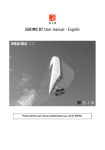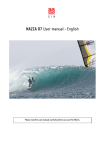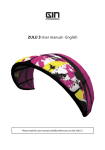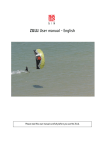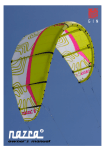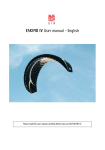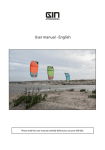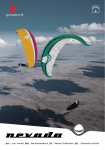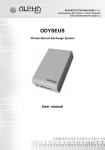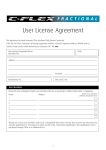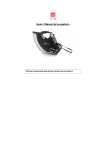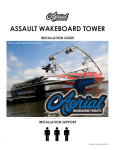Download MAORIUser manual - English
Transcript
MAORI User manual - English Please read this user manual carefully before you use the MAORI. Welcome to GIN… Thank you for choosing a GIN kite. Our R&D team has invested a lot of time, passion and experience into creating the MAORI. We hope you will enjoy this kite as much as us, and we wish you many wonderful sessions with your new MAORI ! Kiting, Paragliding and Speedflying are our passion and we do our best to develop our products and to share our feelings and sensations through GIN. For more information and to keep in touch with the fantastic evolution of our sport, visit our website: www.gingliders.com Please pass on this manual to the new owner if you ever resell your wing. Enjoy riding GIN, The GIN Team Information about safety Aimed at customers with a good knowledge of kiting, this manual principally provides technical information about the MAORI. This manual cannot replace training from an approved kite school. Kiting is a magnificent sport, but certain rules do apply and these must never be neglected. As an “ambassador” of our sport, please respect these rules and always keep safety in mind : Respect : the other riders the kite launch and landing zones the riding locations the rules of riding and of the air the public and their safety the natural elements Familiarize yourself with : your equipment your safety equipment Make sure that you have adequate personal and third party liability insurance for kiting. The manufacturer of GIN GLIDERS as well as the distributors and agents of GIN GLIDERS products cannot be held liable for death, personal injury or material damage resulting from any use of this equipment. 2 Table of contents Welcome to GIN….................................................................................................................. 2 Information about safety ...................................................................................................... 2 Table of contents................................................................................................................... 3 Gin Gliders ............................................................................................................................ 4 History of the MAORI ............................................................................................................. 5 For which level of riders…..................................................................................................................6 Construction .....................................................................................................................................6 Description of a tube kite ...................................................................................................... 7 Control bar of the MAORI ....................................................................................................... 8 Description of the MAORI's bar ...........................................................................................................8 Swivel System.................................................................................................................................10 Adjusters ........................................................................................................................................10 Depower line ...................................................................................................................................10 5th line ............................................................................................................................................11 Lineplan..........................................................................................................................................12 Safety system of the MAORI :............................................................................................... 14 Main quickrelease............................................................................................................................14 To connect a kite leash (for un-hooked riding) ...................................................................................16 Accessories ......................................................................................................................... 17 Technical details.................................................................................................................. 19 Looking after your kite........................................................................................................ 20 Technical data ..................................................................................................................... 21 Acknowledgements.............................................................................................................. 22 3 Gin Gliders GIN Gliders was formed in 1998 by paraglider designer and competition pilot Gin Seok Song and his team of engineers and test pilots. Robert Graham developed his first paraglider in 1980 and created his first kite in 1990: the “C” which remains the reference for many kite pilots today. Robert has left his mark on kite design history with many significant models. Robert now manages the development of GIN kites ; He joined the GIN family in January 2005. The GIN Gliders philosophy is simple : to design equipment that Gin, Robert or any other pilot, will appreciate and enjoy. This philosophy applies equally to a wing for kiting or speedflying, as well as a world-beating competition glider. No product is released onto the market unless Gin and Robert are completely satisfied. Gin has over 25 years' experience of designing and manufacturing kites and paragliders, and is backed up by an equally experienced team, both within the company in Korea and throughout a worldwide network of distributors and dealers. This high level of expertise provided by dedicated professionals ensures that you get the best possible product support and after sales service. Robert Graham 4 History of the MAORI The Maori are people who lived in what is now known as New Zealand. Ancient Maori were expert kite makers and flight controllers. Their kites were used for light-hearted entertainment, competitions and for highly significant spiritual rituals. Kites were also believed to be messengers; like birds, kites were considered to have spiritual connections with the Gods… It is not by chance that our new tube kite is called the MAORI. Like Maori people, the GIN development team wanted to create a pure kite, concentrating only on the essentials for kitesurfing. No superfluous details; we wanted a simple but effective product that allows you to concentrate on your ride. Flying the Maori, the rider feels connected to his kite in a way that allows him to take advantage of the conditions and to appreciate the elements. With the MAORI, Robert Graham has designed a kite with an incredible wind range that offers you a smooth and safe ride. The MAORI is very instinctive and it will help you to be very effective with your wakeboard style tricks or giving you the boost to jump very high ! High points of the MAORI are : - a huge wind range for a classic kite - an active 5th line - superb handling - smooth and quick response - powerful 5 For which level of riders… Thanks to its smooth flight and its very easy re-launch, the MAORI is suitable for all levels of riders : from the motivated beginner to the good or top-level rider. Construction Highly skilled staff takes extreme care during the entire manufacturing process of our kites. Every piece of fabric, reinforcement and detail has been carefully designed, refined and crafted from the most suitable, selected materials. Everything is then assembled in a finely controlled process to create this kite. After several hours of use, you will still discover small details that simplify your kiting life as a result of the thought GIN put into the design for you. By following these concepts and these methods of construction, GIN reinforces its position as a reference in terms of the quality of manufacture of its products. 6 Description of a tube kite 1. leading edge (main tube) 2. BB0 (strut) 3. BB1 (strut) 4. BB2 (strut) 5. BB3 (strut) 6. BB4 (wingtip strut) 7. wingtip 8. trailing edge 9. top 10. bottom 7 Control bar of the MAORI Description of the MAORI's bar 8 1. combined front line 2. front pre-line 3. streamer 4. depower line 5. main safety system (solid sleeve) 6. swivel (swivel system) 7. chicken-loop 8. stoosh 9. quick release of the leash (quick leash) 10. Leash of the 5th line 11. 5th line 12. right rear line (yellow) 13. left rear line (blue) 14. front pre-line 15. rear line adjusters 16. float 17. elastic for holding folded lines 18. carbon bar (47 / 56 cm) 9 Swivel System The swivel of the chicken-loop (swivel system) allows you to cancel any twists on the front flying lines and on the 5th line leash. To cancel the twists after a jump with one or more rotation(s), it is easy to turn the bar first to cancel the twist on the rear flying lines, then to pull down the bar. The act of pulling down the bar relieves pressure on the swivel and allows it to automatically rotate, cancelling any twists in the front lines and the 5th line. Adjusters The adjusters of the rear pre-lines allow a quick and precise adjustment of the line lengths. Depower line The depower line can be changed easily without tools. You just need to make a bowline knot to each end of the depower line on the metal triangle of the streamer, then to fix the ring of the safety system with a lark's head knot. Neutral position of the bar 10 The neutral position of the bar allows easy adjustment of the length of the 5 lines. The streamer must be completely un-tightened and the bar must be pushed up. Then hold the chicken-loop and tighten all 5 lines : all of the 5 lines must end at the same level = wingtip of the kite (11). When the MAORI is completely new, the front flying lines and the 5th line will be around 10 cm shorter than the rear flying lines. After a few hours of use, the front flying lines and the 5th line will lengthen. 5th line The 5th line is active. It will automatically absorb each gust to make the MAORI safer and smoother in flight. For an effective 5th line, it’s correct length is important. With the neutral position of the bar, the 5th line must be the same length as the rear flying lines. Adjust the 5th line by connecting the tail of the “Y” of the kite (2) to the knot that aligns with the end of the rear flying lines. The MAORI is delivered with a complete 26m set of 5 lines. 11 Lineplan 12 1. V of the Y of the kite : MAORI 7 : 2 x 135 cm MAORI 9 : 2 x 154 cm MAORI 11 : 2 x 180 cm MAORI 14 : 2 x 210 cm MAORI 17 : 2 x 236 cm 2. tail of the Y of the kite, 5th line connector : MAORI 7 : 85 cm MAORI 9 : 68 cm MAORI 11 : 82.5 cm MAORI 14 : 107 cm MAORI 17 : 114 cm 3. active 5th line 4. front flying lines, 21 m 5. left rear flying line (blue), 26 m 6. right rear flying line (yellow), 26 m 7. connector ring of the front lines. The 5th line must pass through it. 8. combinated front lines, 5 m 9. stop bar ball 10. distance of the stop bar ball to the end of the leash : MAORI 7 : 291 cm MAORI 9 : 327 cm MAORI 11 : 354 cm MAORI 14 : 400 cm MAORI 17 : 439 cm 11. level zero for the 5 lines 13 Safety system of the MAORI : It is imperative that you know the correct operation and assembly of your system safety before using it. Always check your safety system before each use to make sure that it functions correctly. Main quickrelease 14 1. The solid sleeve from the main quick release is around the depower line. The depower line is fixed with a lark's head knot on the ring of the quick release system. 2. Pass the rigid webbing through the metal rectangle of the chicken loop following the arrow on the picture. 3. Press together the 2 layers of webbing. 4. Cover the 2 layers of webbing with the solid sleeve. 5. Lock the quick release by pulling down the solid sleeve against the metal rectangle of the chicken loop. 6. To release : push the solid sleeve away from you, following the 2 arrows on the picture. You will still be connected to the kite by the leash of the 5th line. Quick leash 1. Hold the metal leash ring in your hand. 2. Pass the "A" batten through the metal ring and place the ring on the red elbow. 3. Fold the "A" batten, then cover the "A" batten batten with the "B" batten. Lock the quick release by unfolding the neoprene cover over the 2 battens. The end of the "B" batten must be visible out of the neoprene cover. 4. To release : pull the neoprene cover in direction shown to release the leash.. 15 To connect a kite leash (for un-hooked riding) 16 1. Hold the locker of your kite leash. 2. Connect the kite leash to the metal leash ring. 3. Move the neoprene cover back in the direction shown to release the 2 leashes. 4. Ready to ride un-hooked with the safety system on the 5th line. To fix the 5th line leash back again : repeat the steps 1, 2, 3 in opposite direction. Accessories MAORI is delivered with 2 specially designed bags. Main rucksack : - Kite board straps and compression straps - External pocket for the pump - Waist belt strap - Ventilation system and zip to allow the wing to dry to let water and sand out. - The 2nd bag is in the internal lid pocket of the rucksack 2nd bag : - Designed to carry the Maori with inflated struts - With the kite packed inside, it is possible to carry it either, across your shoulder, or to place it inside the main rucksack and to carry it on your back. - Wing size logo - Ventilation system, also allows water and sand out 17 GIN pump - 18 XL pump with Aluminium stem Pump leash with quick-lock release to fix to the MAORI main leading edge strut handle Technical details Struts : All struts (BB1, BB2, BB3, BB4) have been designed with 4 fabric panels, which enables them to benefit from a section that is close to a perfect circle. The absence of segments along the struts makes it possible to respect the chosen profile as well as possible, without the problems created by additional seams. End of struts : - Each BB1, BB2, BB3, BB4 is equipped with a pocket on the trailing edge. The pocket was designed to hold the bladder in place and to protect it. The bladder is thus protected by 10 cm more material than the length of the strut. - In order to close the pocket correctly, it should be folded towards the strut, whilst taking care to correctly position the 2 bands of Velcro one on top of the other. Pigtails and flying lines : The MAORI is delivered with front line connectors that have a loop and on the kite, the pigtails are equipped with a knot. This is in order to avoid any risk of confusion at the time of connection. The MAORI lines are however adjustable, and can be used with either a knot or a loop. It is up to you to choose the connection system that suits you. A logical colour code is used to avoid any risk of mistake during connection. Fronts = red / right rear = yellow / left rear = blue, 5th line = grey. Handle on the main leading edge tube : The main leading edge tube is equipped with a double use handle : - It enables you to attach the strap of the pump to it, in order to inflate the MAORI without holding the kite. - You will benefit from an easy and safe handhold to carry your MAORI up-wind, inner-surface facing up, top surface down. Safety handles: If you need to return to the beach while sitting in the kite, the 2 safety handles sewn on the strut wing tips will be convenient for steering the MAORI as well as possible. 19 Looking after your kite - Do not leave your kite out in the sun or flapping in the wind if you are not using it, the cloth will prematurely age. - Never store a wet kite for a long time. Make sure it is completely dry. - Never use any sort of chemical cleaner for your kite. Only use normal water. - Store your kite in a dark and dry place leaving the bag open. - Do not walk on the lines or on the kite. - When you are preparing to store the MAORI for a long time, we advise you to deflate it completely, and to open all the valves. This will avoid any risk of the valve plugs becoming deformed and not sealing properly. Control bar set-up and safety system : - Check your control bar set-up and safety system before each use to make sure that it works correctly. - Check for wear and tear on each part, also check all knots and lines, making sure that the neoprene protectors are in place where appropriate. - After each use, clean the control bar set-up and safety system with normal water. Sand considerably increases wear. Take care to clean your control bar set-up and your safety system of all sand, mud and dust. Warning : - Your safety and the safety of others depend upon the correct use of this equipment. You are solely responsible for ensuring that you only use this equipment in situations and conditions suitable for your level of competence and in a way that will not endanger third parties. - Safety does not only depend on the safety systems of the kite, it is also the result of training and of the correct evaluation of the situation and all conditions; the location, potential hazards, other people, the weather, etc - It is extremely important to receive proper training before using this product and to fully familiarise yourself with all emergency procedures in safe conditions, before having to resort to them in an emergency. The safest place to obtain the necessary skills is from a suitably qualified and competent kite instructor or school. Do not attempt to fly this kite without the necessary skills. - Your kite and safety systems must be regularly checked and properly maintained. 20 Technical data WARNING : This table is not 100% applicable. To make it complete you have to consider several datas that can modify the windrange, like : - the weight of the rider - the level of the rider - the performance of the board - the altitude and specificities of the spot - etc... Flat surface area : Aspect ratio : MAORI 7 : 7 m MAORI 7 : 4.8 MAORI 9 : 9m2 MAORI 9 : 5.1 MAORI 11 : 11 m2 MAORI 11 : 5.4 MAORI 14 : 14.4 m2 MAORI 14 : 5.6 MAORI 17 : 17.2 m2 MAORI 17 : 5.9 21 Acknowledgements Gin Gliders would like to thank the Development Team riders who contributed to the development of the MAORI. Their effectiveness, their optimism and their ideas brought much to the result that is the MAORI. Thank you also to all the impassioned people who have given their energy and time for the MAORI. 22























